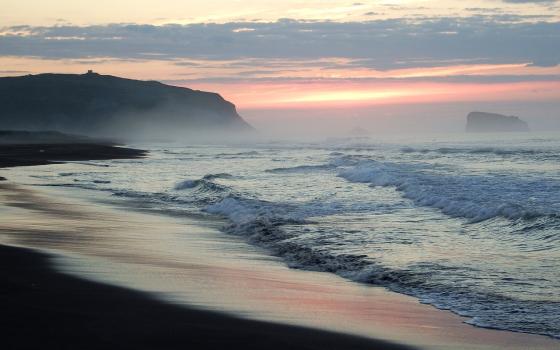What does the Jesus of Good Friday have to do with the Pacific Ocean?
In Laudato Si', on Care for Our Common Home, Pope Francis writes, "In the Christian understanding of the world, the destiny of all creation is bound up with the mystery of Christ … 'All things have been created through him and for him' (Col.1.16) … the mystery of Christ is at work in a hidden manner in the natural world as a whole." Francis reminds us that our earth is a "mother who opens her arms to embrace us … [but] we have come to see ourselves as her lords and masters, entitled to plunder her at will."
The Good Friday liturgy puts before us Jesus, the Suffering Servant: "He was despised and rejected by others, a man suffering and acquainted with infirmity; and as one from whom others hide their faces, he was despised and we held him of no account"(Isaiah 53:3).
Once I flew from New York to California. I had been away from Australia for some months. As the plane neared Los Angeles, I looked down and sighted the familiar, beautiful Pacific Ocean. I felt joy because I knew I was on my way home. I had grown up on the eastern coast of Australia, and the Pacific nurtured my love for the ocean, its life and those who live on its islands.
The islands of this ocean are home to many different peoples, speaking hundreds of languages. Some, like the Philippines, New Zealand, Indonesia and Japan are well-known.
Less known, yet equally important, are the people: Polynesian, Micronesian and Melanesian — all have lived in the Pacific for thousands of years. The Pacific has been the mother who protected and sustained them.
I spent considerable time during my ministry among the Melanesian and Polynesian peoples, whom I called "rainbow people" because of their colorful beauty. It was always a surprise and delight for me to learn about their cultures, languages and way of life.
I was particularly interested in their dancing, and their reasons for dancing; eventually I was able to tell their islands of origin by the way they danced. The Melanesian people of Papua New Guinea danced on serious occasions like funerals or at war dances — with much stomping of feet. In the Solomon Islands dancing was accompanied by flute and drums. In Polynesia, dancing was a joyous celebration of their culture and included wonderful arm and finger movements.
In living among these generous people, I learned that to survive I had to depend on them and trust them. Yet, I was often appalled at how they were treated. Many of these beautiful people can identify with Jesus, the Suffering Servant, as their needs are ignored and their countries exploited by the wealthy and powerful of the world.
While teaching in Melanesia on Bougainville, Papua New Guinea, I experienced the beginning of a vicious ten-years civil war, in which thousands of people died. In part it centered around the peoples' exploitation by foreign owners of one of the world's largest copper mines.
In the Solomon Islands, I saw foreign companies raping the sea with drift net and long line fishing; they were also logging the land, which resulted in disastrous mud slides. Local people showed me wrecked planes and tanks dumped by troops after World War II.
Because many Pacific Islands in Micronesia are low-lying coral islands, people are struggling with rising sea levels and the destruction of their homes due to global warming.
I taught in Samoa in the mid-1990s, during the latter years of the French nuclear testing. The people's main food crop, taro, became diseased with taro leaf blight, and I wondered if in some way this may have been connected to atmospheric nuclear fallout, as Samoa is only an hour's flight from French Polynesia.
Nuclear testing in French Polynesia had been done over several decades, and nuclear testing and nuclear waste are still contaminating the Pacific. Nuclear ballistic missiles are still being fired into the northwestern rim of the ocean.
In the same area, a tsunami caused one of the world's worst nuclear reactor disasters, and toxic waste from that is likely to be dumped into the sea.
Just recently, it was reported that highly contaminated radioactive nuclear waste is leaking on Runit Island, near the Marshall Islands, halfway between Australia and Hawaii. The waste had been buried by the USA in the late 1970s, under a vast 85,000 cubic meter concrete dome. This dome is now cracking and people who live on surrounding islands fear for their lives and for the widespread contamination of the Pacific Ocean and its food chain. It would likely be the largest nuclear cleanup in US history.
Closer to home, here in Australia, the Pacific Ocean offers us many great treasures. Among these is the World Heritage Great Barrier Reef. Sadly, so much of the reef is dying due to global warming, illegal poaching of fish, increasing numbers of the coral-eating crown of thorns starfish, and chemical run-off from agriculture and mining.
Mine run-off is a significant problem. There is fierce opposition to the government support of the development of the foreign-owned Adani Carmichael mine in Queensland, which would be the largest coal mine in Australia. The Sydney-based Climate Council of Australia recently warned the government that this mine would be a disaster for the Great Barrier Reef, for global warming and for people's health.
Another Australian treasure is our whales, particularly humpback whales. These amazing creatures make their mating journey annually from the Southern Ocean to the Reef. Afterwards the whales — including the mothers and calves — travel back to their home in the Southern Ocean, where they are facing major problems.
Because of global warming, Antarctic ice sheets may be melting more quickly than anticipated. Whales' major food source is the tiny krill that thrive in icy waters. As the ice melts, the migrating whales will be forced to travel much further south to their food source. The other danger is that they are still being illegally slaughtered by Japan, and perhaps for political, diplomatic reasons little is said about this.
As an Australian woman of Celtic origin, I have absorbed Christian Celtic spirituality in which the Divine presence was recognised in nature, landscapes and in the sacredness of everyday places. I have been influenced by Australian indigenous peoples' spirituality of the land, in which the earth is our mother from whom we come and to whom we return.
Reflecting on Scripture and theology has deepened and broadened my understanding of the presence of Christ, "the firstborn of all creation … in whom all things have been created."
I have been influenced by the thinking of Teilhard de Chardin, who saw the cosmic Christ as the Omega point of all creation, and by Saint Francis, who called Water his Sister.
So I believe that a oneness exists between the sufferings of creation and those of Christ, the Suffering Servant.
I believe that the Pacific Ocean, with all its peoples and living creatures, reflects Jesus, the Suffering Servant. So I conclude with a simple poem I wrote about our connectedness with the ocean:
I've a passion for the sea, and it's renewed in me
Each time I stand and let it be a part of me.
[Karan Varker is a Sister of Charity of Australia. She has been a teacher in in Papua New Guinea, America Samoa and Australia, served as a principal in Australia and Samoa, and trained Catholic teachers in Samoa and the Solomon Islands.]

